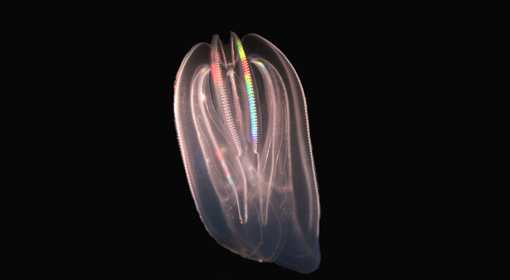Sea Jellies
Sea jellies swim using rhythmic contractions of their bells. As the bell pulses, it creates an area of low pressure around their body. This helps to draw water from in front to behind the bell, which is then pushed backwards, thereby propelling the animal forward. Sea jellies are the most efficient swimmers in the ocean!
 The synchronous beating of the comb jelly’s ctenes generate colourful hues. Credit, Cornelia Jaspers.
The synchronous beating of the comb jelly’s ctenes generate colourful hues. Credit, Cornelia Jaspers.
Comb jellies
Comb jellies swim in a completely different way to cnidarian jellies. They use the synchronous beating of their eight ctene rows (a little like a Mexican wave!) to propel themselves through the water. As the ctenes beat, they refract light, generating rainbow like waves of light that radiate along their bodies. Some comb jellies have a pair of big lobes. Lobate species usually swim by beating their ctenes but if they perceive danger, they can clap their lobes together to expel water and rapidly propel themselves away from the threat.